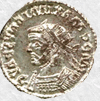

The monument reaches more than four hundred meters of longitude for two hundred meters width and it presents an original design. It is organised around a cryptoportico of semicircular layout, which is constituted by an underground gallery of four meters high and four meters and half a of width. Allows the creation of a great horizontal terrace around of which the different buildings that compose the group are agglutinated. On this cryptoportico there was a corridor with a portico from which the access to the different buildings and spaces of the complex was carried out.
At the top of the semicircular square and in coincidence with the axis of the monument is situated the great room of imperial representation. This is the room of more dimensions and relevance of the whole group. There did the imperial audiences take place, having the emperor's presence located in the apse.
The thermal baths which that conform a small reserved establishment to the emperor and their close characters, are located right to the north of the reception room. Probably the room and the thermal baths were directly communicated, to allow the emperor to retire to the intimacy of the thermal baths after the conclusion end of the audience.
Around the semicircular piazza, to both sides of the room of imperial audience, two other rooms of similar characteristic but of inferior dimensions are prepared. The one located on the north, does still conserved leaves of their raised and the pavements constituted by mosaics decorated with geometric motives and vegetables. Her twin on the south, is located in the beach of roads of the railroad station, satiny at level of foundations when the excavations began. Their function must have been the one of serving as audience room for important positions of the imperial court (comitatus) or there must ave stayed officials related with the administration of Hispania.
Something similar happens with the polyapses rooms located in the ends of the semicircular piazza, closing their layout, whose function would be to welcome other officials of the court.
The palace is besides composed by other buildings that look like the imperial apartments. They are in an area far from the rooms of public audience and constituted by stays of more reduced dimensions, dedicated to the rest and the emperor's residence

